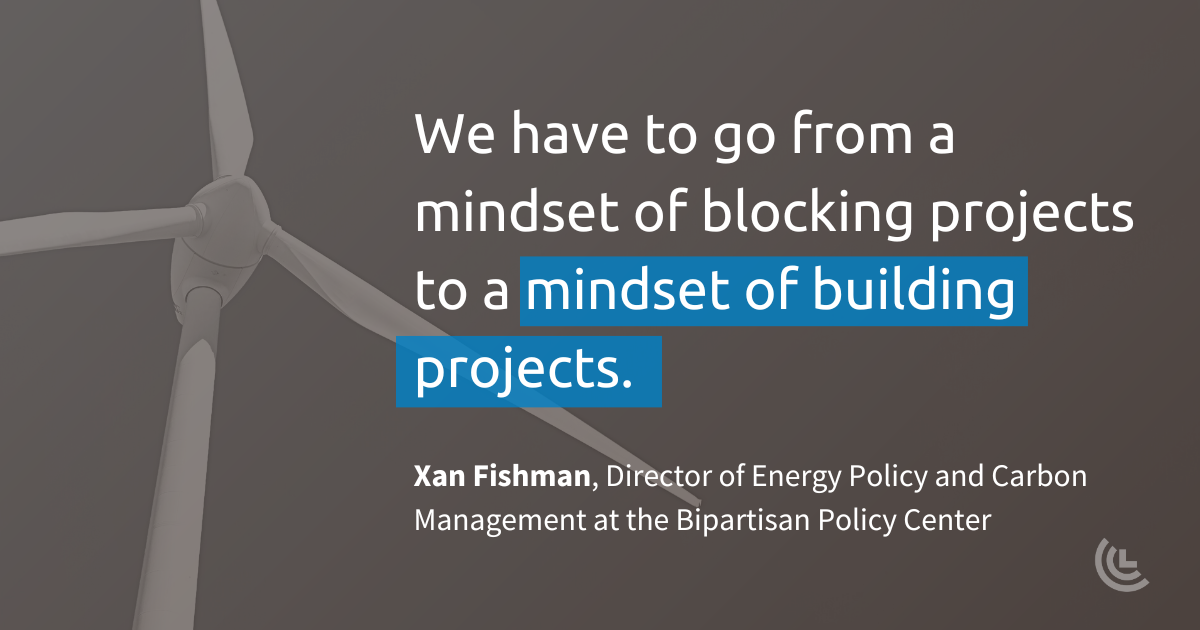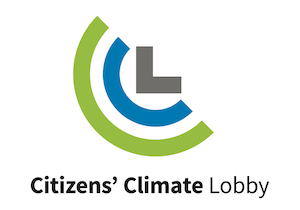Hear from the experts on permitting reform
By Samantha Johnstone
Permitting reform — it’s “the most boring topic that is of utmost importance,” Xan Fishman jokes. Fishman is the Director of Energy Policy and Carbon Management at the Bipartisan Policy Center, and at our last conference, he joined a panel discussion about permitting alongside Chad Whiteman from the U.S. Chamber of Commerce’s Global Energy Institute and Elan Sykes from the Progressive Policy Institute.
Watch the panel here, moderated by CCL’s Senior Director of Government Affairs, Jenn Tyler, or read on for a recap below.
The importance of the Inflation Reduction Act
Kicking off the panel, Tyler started off simple by noting CCL’s involvement with the passage of the Inflation Reduction Act (IRA). She asked the panelists to weigh in on the legislation’s significance, how it relates to permitting, and what next steps may be.
Fishman explained that for decades, the goals of environmentalists were typically blocking projects or stopping development. But as the world continues to change and evolve, it is not enough to simply halt projects. “We have to go from a mindset of blocking projects to a mindset of building projects,” he said. “That is the only way to decarbonize. The Inflation Reduction Act set up tax credits […] but if we want all of the federal dollars funding these incentives to come to fruition and we actually want to decarbonize, then we have to build.”
Whiteman followed up with evidence from a recent Princeton Environmental Research study, “Can the 2022 Inflation Reduction Act get us to net-zero?” led by Jesse Jenkins. Jenkins found that if permitting isn’t accelerated, we could miss out on up to 80% of greenhouse gas reduction that could have been achieved under the IRA. And one of the biggest roadblocks is an inefficient supply chain.
“We can take the technology and we can build the offshore wind, we can build the solar. But we need the minerals here — we need the supply chain here,” Whiteman said. “Right now, over 80% of supply chains are not controlled by the U.S. or within the U.S.”
Whiteman believes we need more mining within the country so that we can drive the markets, keep costs down, and follow the highest of environmental standards.
Sykes chimed in, noting that the IRA allocated money for agencies to ensure they have adequate resources to do their job efficiently, which is extremely important as it is easy for permitting and decarbonization to get stuck and lost within the process.
The permitting reform section of the debt ceiling package
Congress included some permitting updates in this summer’s debt ceiling package, which the panelists weighed in on.
Fishman explained that there were many meaningful changes to NEPA, including some that he highlighted. The first being that when comparing alternatives, it must be economically efficient, technically feasible and fit the purpose in need of the project. Secondly, there should be one lead agency coordinating the activities of all other agencies, thus having a schedule, timeline and set practices in case of a disagreement.
Fishman believes the best part of this policy is that everybody gets something that they want. “You get decarbonization. You get cheaper energy. You get more reliable energy. You get better energy security. And you get a better quality of life, it’s just a win-win,” he said.
Sykes followed up, noting that programmatic review would be a good add-on to the package in coming years. Each project requires multiple different permits, so pooling them all together and looking from a birds-eye view allows them to analyze the impact and figure out what the criteria is for approving a project. Thus, before a new project is started, it is clear what mitigation measures might be necessary and what the impact will likely be, making the permit approval process as a whole faster.
“Finding ways to be even more effective at triaging what the real problems are and engaging with communities that are trying to engage with the process and provide public input is really important too,” Sykes said. “We need to use our fixed set of bureaucratic resources more efficiently to focus on the biggest impacts, the biggest problems, and the most complex projects.”
Controversies and proposals surrounding transmission
Tyler noted that Democrats are a lot further along on the topic of energy transmission than Republicans, and as CCLers, one of our primary goals should be to encourage Republicans to understand the need for transmission. But what exactly is transmission, and how can one distinguish between all the different proposals?
Fishman explained that transmission has three main components: siting, cost allocation, and minimum transfer.
- Siting – Thinking about how a project will disrupt surrounding people and their daily lives, livelihoods and routines. Also factoring in proximity to natural resources. Most siting is done state-by-state, meaning they use their laws and control the siting, rather than the federal government taking over control.
- Cost allocation – Typically calculated via a formula, analyzing the benefits and how it will be distributed over a grid. The issue is that regions use different formulas, so a power line going across several regions causes disagreements over what formula to use. There is talk about a federally imposed cost-allocation formula, but it is extremely controversial because benefits such as greater electricity reliability or lower electricity costs are valued differently in different regions.
- Minimum transfer – In times of need, regions can transfer electricity from one to another. But some regions only have a 2% transfer capacity between them, while others have as much as 20%. The BIG WIRES Act is a bill that would require a minimum amount of transfer capacity in between two weeks.
Fishman explained that the key to success is finding the right balance of these three elements, one that pleases both Democrats and Republicans. Whiteman agreed, emphasizing just how complicated it is to allocate benefits and costs when each region is so uniquely different. Sykes chimed in, adding that longevity of a program like this is arguably the most important part, which can be ensured by legislative objectives.
“It’s important to get legislative approval for changes [like this] because that ensures that they will last across different presidential administrations and can be really valuable for long term projects like transmission lines,” Sykes said.
Focusing on community engagement
Tyler highlighted a common concern that frontline communities will be most impacted and harmed by changes to the permitting process. Encouraging community engagement throughout the process is a valuable tool to help remedy this solution, and Tyler asked the panel what responses and policies they are looking to to help improve community engagement.
Sykes kicked it off, mentioning that he lives in Washington, D.C., and frequently attends neighborhood meetings regarding topics such as a new bike lane. He finds that public opinion is often misrepresented in these situations, as people who cannot attend (because they might be working or taking care of children) aren’t given a voice.
“I think it is really hard to account for the feelings of a community holding in just a few meetings, and we don’t really know what the next form of better engagement is,” Sykes said.
He acknowledged that he doesn’t have a perfect solution, but he is skeptical of the changes to judicial reform that the permitting deal touches on.
“It’s very expensive to conduct lawsuits and use them as a way to express public feedback,” Sykes said. “I think that engaging communities and the public stakeholders earlier is always better than later.”
Whiteman noted that a shift in perspective could also be helpful. “Instead of just looking at all the environmental harms that could be associated with a project, we’re also looking at some of the economic and other benefits that could happen,” Whiteman said.
This way, the community can get a better and more accurate picture, being able to make more informed comments and opinions. Fishman agreed with sentiments regarding earlier engagement and more information, but also brought up the involvement of developers.
“Developers want to do public engagement, and they are inherently mistrusted by local communities,” Fishman. “If we decrease the role of the product developer in the public engagement process […] you have to get some neutral party.”
Fishman proposed an organization centralized within the federal government, who might be working with local trusted partners, civic organizations or even extension partnerships through the Department of Agriculture. By teaming up resource expertise already trusted by the community, the process could go much more smoothly.
Working together for positive, lasting change
From there, the panel transitioned into a Q&A from the audience, then closed up by touching on one piece that they want to see in good permitting reform legislation, For Whiteman, it’s judicial reform. For Sykes, it’s transmission reform that is ambitious but will manage to hold up over time, preferably a comprehensive bipartisan deal as it is the best, most durable product. And for Fishman, he believes a bipartisan deal is the only way to make it work.
“You take the things that Democrats really want and the things that Republicans really want, and you put them together in a package. And it’s gonna work because the things Democrats really want, the Republicans don’t despise. And the things Republicans want, the Democrats don’t despise. It’s not their preference, it’s not what they really want, but it’s okay. And everybody ends up with a greater improvement and everyone is better,” Fishman said.
Make sure Congress has heard your voice on permitting reform — contact your representative and senators about this today!
Samantha Johnstone is an intern with CCL’s Communications team. Class of 2026 at Cornell University, she is studying Environment & Sustainability with an emphasis in environmental humanities and a minor in communications. Originally from the Bay Area, she is part of the San Mateo County CCL Chapter.






